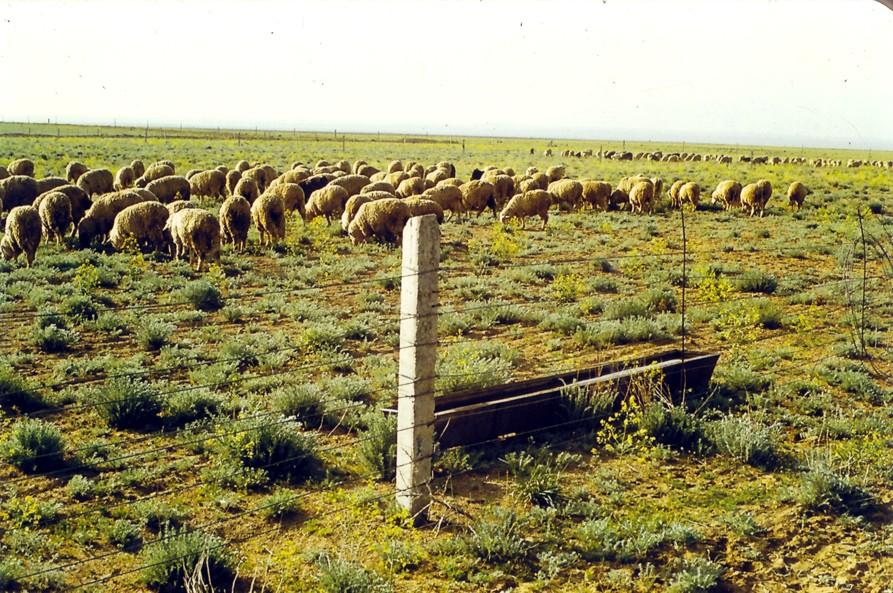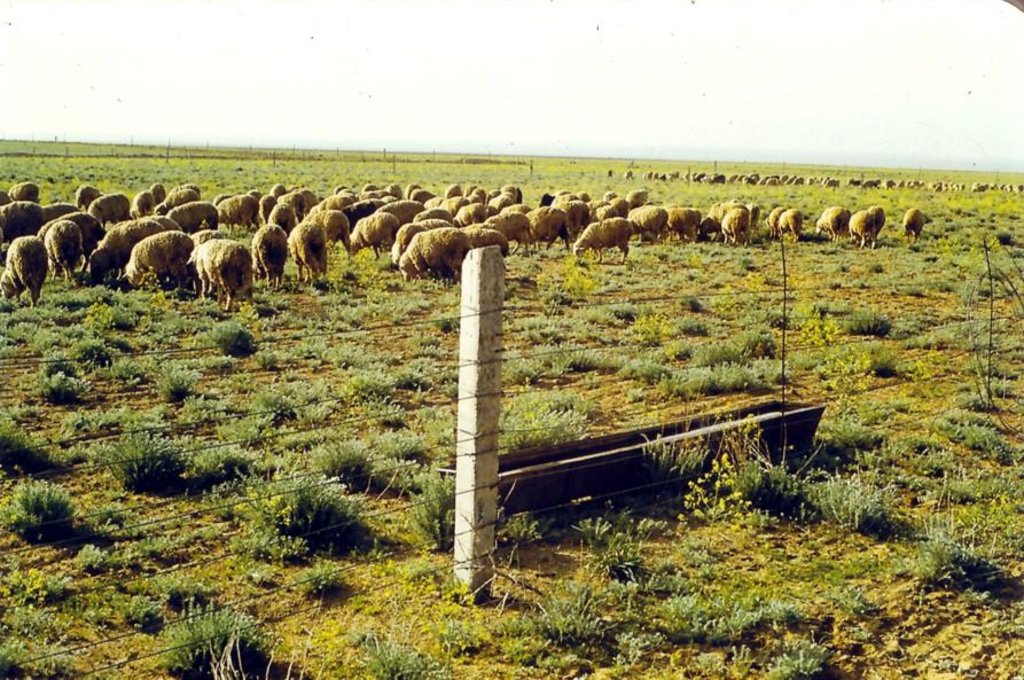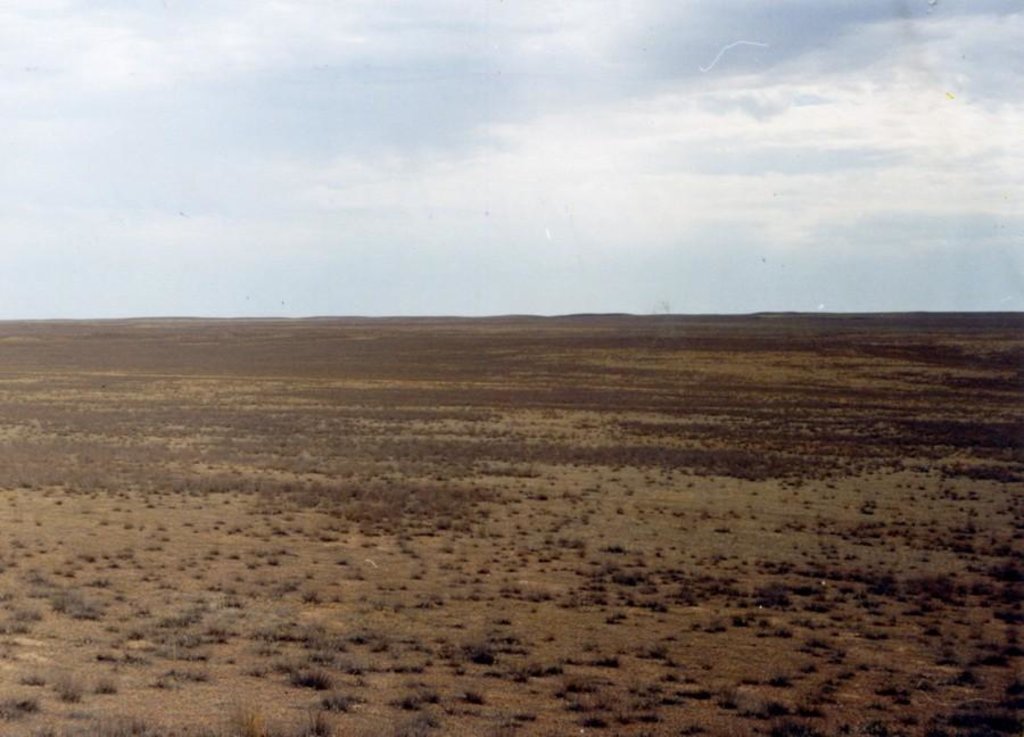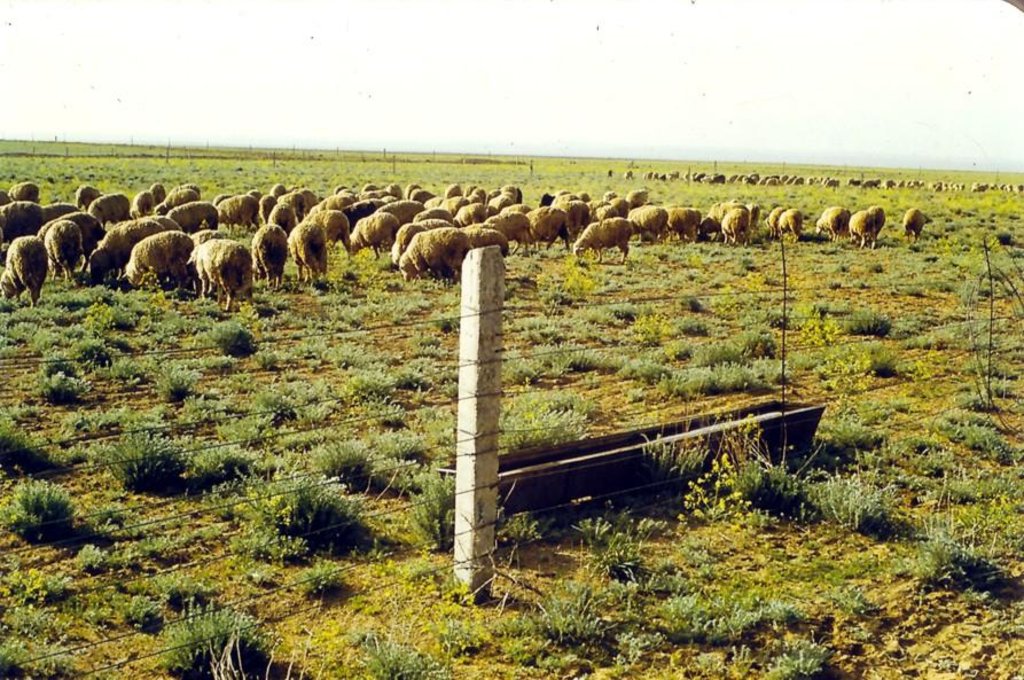Creation of sowed pastures from subshrubs and forbs able to use maximally the scanty water resources [คาซัคสถาน]
- ผู้สร้างสรรค์:
- การอัพเดท:
- ผู้รวบรวม: Irina Skorintseva
- ผู้เรียบเรียง: Hayot Ibrakhimov
- ผู้ตรวจสอบ: Fabian Ottiger, Rima Mekdaschi Studer
approaches_2362 - คาซัคสถาน
ดูส่วนย่อย
ขยายทั้งหมด ย่อทั้งหมด1. ข้อมูลทั่วไป
1.2 รายละเอียดที่ติดต่อได้ของผู้รวบรวมและองค์กรที่เกี่ยวข้องในการประเมินและการจัดเตรียมทำเอกสารของแนวทาง
วิทยากรหลัก
ผู้เชี่ยวชาญ SLM:
Alimaev Ilya
+8(3272) 21-44-46
alimaev@nursat.kz
SPC for livestock husbandry and viterinary RK
51 Jandosov Str, Almaty 480035
คาซัคสถาน
ผู้เชี่ยวชาญ SLM:
1.3 เงื่อนไขที่เกี่ยวข้องกับการใช้ข้อมูลที่ได้บันทึกไว้ผ่านทาง WOCAT
ผู้รวบรวมและวิทยากรหลักยอมรับเงื่อนไขเกี่ยวกับการใช้ข้อมูลที่ถูกบันทึกผ่านทาง WOCAT:
ใช่
1.4 การอ้างอิงถึงแบบสอบถามเรื่องเทคโนโลยี SLM
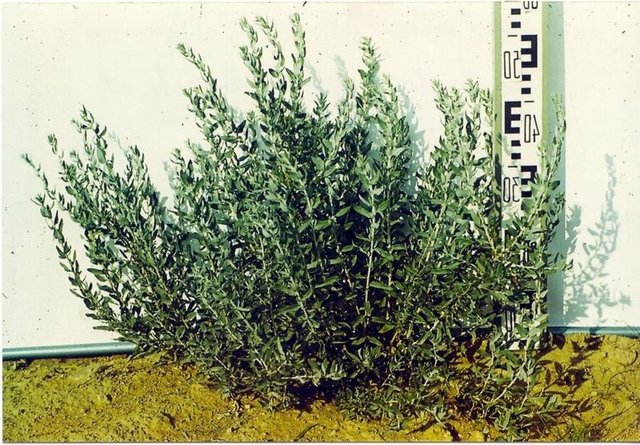
Creation of artificial pasturable phytocenosis at north desert … [คาซัคสถาน]
Selection fodder plants and the technology of their cultivation for maximal use of poor soil water in desert
- ผู้รวบรวม: Unknown User
2. คำอธิบายของแนวทาง SLM
2.1 การอธิบายแบบสั้น ๆ ของแนวทาง
Increase of use effectiveness of limited resources of soil moisture in desert with sowing xerophyte fodder plants
2.2 การอธิบายอย่างละเอียดของแนวทาง
การอธิบายอย่างละเอียดของแนวทาง:
Aims / objectives: Vegetation of North desert in modern condition is defective as cenosis owing to anthropogenic factor. Existing phytocenosis is characterized by low saturation of soil with plant organs. Therefore such cenosis can not use material resources of soil maximally (rootage penetrate into soil not more than 80 cm depth). Creation of sowed pastures with plant such as Kochia, Salsola, Artemisia, Ceratoides gives the possibility to use soil resources (first of all, moisture) more, better due to powerful rootage penetrating into soil up to 2.5 m). The method was approved and allows to increase productivity by 2-2.5 times. Studies in South Pribakhashye showed that in spring soil under degraded pasture contain 295-474 tons of productive moisture, 32-57 tons of humus,3-8 tons of common nitrogen per ha. At the same time association of sowed sbushrubs occupies soil layer 0-250 cm, what contains 652-1080 tons of productive moisture, 50-61 tons of humus, 11-52 tons of common nitrogen per ha. Degraded pastures could form 210 kg of dry matter per ha while pastures created on SWC-method - up to 580-600 kg per ha.
2.3 รูปภาพของแนวทาง
2.5 ประเทศ ภูมิภาค หรือสถานที่ตั้งที่ได้นำแนวทางไปใช้
ประเทศ:
คาซัคสถาน
ภูมิภาค/รัฐ/จังหวัด: :
South Pribalkhashye
2.6 วันที่เริ่มต้นและสิ้นสุดของแนวทาง
ระบุปีที่เริ่ม:
1974
การสิ้นสุดลง (ถ้าแนวทางไม่ได้ใช้อีกต่อไป):
1994
2.7 ประเภทของแนวทาง
- ใช้โครงงานหรือแผนงานเป็นฐาน
2.8 เป้าหมายหรือวัตถุประสงค์หลักของแนวทาง
The Approach focused mainly on SLM with other activities (on SWC and increase of pasture productivity)
Creation of high productive pastures in place of finally degraded sites of vegetation
The SLM Approach addressed the following problems: Maximal use of moisture as limiting factor of growing and development of fodder plants in desert
2.9 เงื่อนไขที่เอื้ออำนวยหรือเป็นอุปสรรคต่อการนำเทคโนโลยีภายใต้แนวทางนี้ไปปฏิบัติใช้
การมีไว้ให้หรือการเข้าถึงแหล่งการเงินและบริการ
- เป็นอุปสรรค
to implementation of technological processes because of shortage of seeds, machinery, petrol
Treatment through the SLM Approach:
กรอบแนวทางในการดำเนินการด้านกฎหมาย (การถือครองที่ดิน สิทธิในการใช้ที่ดินและน้ำ)
- เอื้ออำนวย
The existing land ownership, land use rights / water rights moderately helped the approach implementation: There was no this problem at implimentation of the method
3. การมีส่วนร่วมและบทบาทของผู้มีส่วนได้ส่วนเสียที่เกี่ยวข้อง
3.1 ผู้มีส่วนได้ส่วนเสียที่เกี่ยวข้องในแนวทางนี้และบทบาท
- ผู้ใช้ที่ดินระดับท้องถิ่นหรือชุมชนระดับท้องถิ่น
Farmers. Working land users were mainly women (The invited specialists of local community worked in creation and implementation of method)
- ผู้เชี่ยวชาญ SLM หรือที่ปรึกษาการเกษตร
- รัฐบาลแห่งชาติ (ผู้วางแผน ผู้ทำการตัดสินใจ)
Ministry of Agriculture, oblast departments of agriculture
ถ้ามีผู้มีส่วนได้ส่วนเสียหลายคนที่เกี่ยวข้องให้ระบุหน่วยงานตัวแทน:
Pryamishnikov S. - selection of cultures and technology of cultivation. Jurchenko V. - selection of cultures and technology of cultivation. Alimaev Y - theoretical base of method, seliction of cultures and technology of cultivation.
3.2 การเกี่ยวข้องของผู้ใช้ที่ดินระดับท้องถิ่นหรือชุมชนระดับท้องถิ่นในช่วงต่างๆของแนวทาง
| ความเกี่ยวข้องของผู้ใช้ที่ดินระดับท้องถิ่นหรือชุมชนระดับท้องถิ่น | ระบุผู้ที่มีส่วนเกี่ยวข้องและอธิบายกิจกรรม | |
|---|---|---|
| การริเริ่มหรือการจูงใจ | จ่ายเงินหรือสนับสนุนจากภายนอก | responsibility for minor steps, casual labour; mashine - operators of community local specialists |
| การวางแผน | ไม่มี | |
| การดำเนินการ | ระดมกำลังด้วยตนเอง | responsibility for minor steps, casual labour; mashine - operators of community local specialists |
| การติดตามตรวจสอบหรือการประเมินผล | ไม่มี | |
| Research | ไม่มี |
3.4 การตัดสินใจเลือกใช้เทคโนโลยี SLM
ระบุผู้ที่ทำการตัดสินใจเลือกเทคโนโลยีมากกว่าหนึ่งวิธีไปปฏิบัติใช้:
- ผู้เชี่ยวชาญ SLM เป็นผู้ตัดสินใจหลัก ที่ติดตามให้คำปรึกษากับผู้ใช้ที่ดิน
การอธิบาย:
Before 1991 the use of method was carried out after consultation with specialists and land users by officials orders
4. การสนับสนุนด้านเทคนิค การสร้างขีดความสามารถ และการจัดการด้านความรู้
4.1 การสร้างขีดความสามารถ / การอบรม
ได้มีการจัดอบรมให้แก่ผู้ใช้ที่ดินหรือผู้มีส่วนได้ส่วนเสียคนอื่น ๆ หรือไม่:
ใช่
ให้ระบุว่าใครเป็นผู้ได้รับการอบรม:
- ผู้ใช้ที่ดิน
- politicians/decision makers
รูปแบบการอบรม:
- ใช้พื้นที่ทำการสาธิต
หัวข้อที่พูด:
science of grosslands, manadement of pasture ecosystems
4.2 การบริการให้คำแนะนำ
ผู้ใช้ที่ดินมีการเข้าถึงการรับบริการให้คำปรึกษาหรือไม่:
ใช่
ระบุว่ามีบริการให้คำปรึกษาหรือไม่:
- ที่ศูนย์ถาวร
การอธิบาย/แสดงความคิดเห็น:
Advisory service is totally inadequate to ensure the continuation of land conservation activities; Further development of marketing and introduction groups is needed in oblast departments of agriculture
4.3 การเสริมความแข็งแกร่งให้กับสถาบัน (การพัฒนาองค์กร)
สถาบันได้รับการจัดตั้งขึ้นมาหรือเสริมความแข็งแกร่งโดยแนวทางนี้หรือไม่:
- ใช่ เล็กน้อย
ระบุประเภทของการให้ความช่วยเหลือสนับสนุน:
- ด้านการเงิน
4.4 การติดตามตรวจสอบและประเมินผล
การติดตามตรวจสอบและประเมินผลเป็นส่วนหนึ่งของแนวทางหรือไม่:
ใช่
ความคิดเห็น:
bio-physical aspects were regular monitored through observations
management of Approach aspects were ad hoc monitored through observations
There were no changes in the Approach as a result of monitoring and evaluation: Technological processes worked throw in details
4.5 การวิจัย
การวิจัยเป็นส่วนหนึ่งของแนวทางหรือไม่:
ใช่
ระบุหัวข้อเรื่อง:
- เศรษฐศาสตร์หรือการตลาด
- นิเวศวิทยา
- เทคโนโลยี
ให้ข้อมูลเพิ่มเติมและให้ระบุผู้ทำการวิจัย:
Technological process was developed on a base of SWC - method and investigation on ecological and economical aspects of effects on nature and people were carried out
Research was carried out both on station and on-farm
5. การสนับสนุนด้านการเงินและวัสดุอุปกรณ์
5.1 ระบุงบประมาณประจำปีสำหรับแนวทาง SLM นี้
ถ้าหากว่างบประมาณประจำปีไม่เป็นที่ทราบแน่นอน ให้ระบุช่วงลงไป:
- < 2,000
แสดงความคิดเห็น (แหล่งของการระดมทุน ผู้บริจาคคนสำคัญ):
Approach costs were met by the following donors: government (national - budget): 100.0%
5.2 การสนับสนุนด้านการเงิน / วัสดุอุปกรณ์ให้แก่ผู้ใช้ที่ดิน
ผู้ใช้ที่ดินได้รับการสนับสนุนด้านการเงิน / วัสดุอุปกรณ์ไปปฏิบัติใช้เทคโนโลยีหรือไม่:
ใช่
5.3 เงินสนับสนุนสำหรับปัจจัยนำเข้า (รวมถึงแรงงาน)
- อุปกรณ์
| ระบุปัจจัยนำเข้าที่ได้รับการสนับสนุน | เห็นด้วยระดับไหน | ระบุเงินสนับสนุน |
|---|---|---|
| เครื่องจักร | ได้รับการช่วยเหลือทางการเงินแบบเต็ม | |
| เครื่องมือ | ได้รับการช่วยเหลือทางการเงินแบบเต็ม | |
- การเกษตร
| ระบุปัจจัยนำเข้าที่ได้รับการสนับสนุน | เห็นด้วยระดับไหน | ระบุเงินสนับสนุน |
|---|---|---|
| เมล็ด | ได้รับการช่วยเหลือทางการเงินแบบเต็ม | |
| Seedlings and biocides | ได้รับการช่วยเหลือทางการเงินแบบเต็ม | |
ถ้าแรงงานโดยผู้ใช้ที่ดินเป็นปัจจัยนำเข้าที่มีอยู่มากมาย ระบุด้วยว่าเนื่องจาก:
- สมัครใจ
ความคิดเห็น:
at introduction of method the land was state property
5.4 เครดิต
มีการจัดหาเครดิตมาให้ภายใต้แนวทาง SLM หรือไม่:
ไม่ใช่
6. การวิเคราะห์ผลกระทบและการสรุป
6.1 ผลกระทบของแนวทาง
ช่วยให้ผู้ใช้ที่ดินนำเอาเทคโนโลยี SLMไปใช้และบำรุงรักษาสภาพไว้ได้หรือไม่:
- ไม่ใช่
- ใช่ เล็กน้อย
- ใช่ ปานกลาง
- ใช่ อย่างมาก
the technology of creation of sowed pastures
Did other land users / projects adopt the Approach?
- ไม่ใช่
- ใช่ เล็กน้อย
- ใช่ ปานกลาง
- ใช่ อย่างมาก
this method is based on teoretical workings of proffesors Ramenskii L.G, Shamsutdinov Z.Sh, Kurkina K.D.
6.3 ความยั่งยืนของกิจกรรมของแนวทาง
ผู้ใช้ที่ดินสามารถทำให้สิ่งต่างๆ ที่ได้ปฏิบัติใช้โดยแนวทางนี้ยั่งยืนได้หรือไม่ (โดยไม่มีการสนับสนุนจากภายนอก):
- ไม่แน่ใจ
ถ้าตอบว่าไม่หรือไม่แน่ใจ ให้ระบุและแสดงความคิดเห็น :
Taking into account the value of carrying out of activities in 1 ha equals US$20-22 one can say only rich commodity producers can apply the method
6.4 จุดแข็งและข้อได้เปรียบของแนวทาง
| จุดแข็ง / ข้อได้เปรียบของแนวทางในทัศนคติของผู้ใช้ที่ดิน |
|---|
| 1) it increases pasture fodder capasity |
| 2) it ceases soil erosion and improves ecological conditions |
| จุดแข็ง / ข้อได้เปรียบของแนวทางในทัศนคติของผู้รวบรวมหรือวิทยากรหลัก |
|---|
| 1)Sufficiently simple technology (How to sustain/ enhance this strength: to work for reduction of technology price) |
| 2) it gives significant effect in increase pasture productivity |
| 3) it is able to localize centers of soil erosion. |
| 4) it promotes animal husbandry development |
| 5) it increases living standards of people |
7. การอ้างอิงและการเชื่อมต่อ
7.1 วิธีการหรือแหล่งข้อมูล
- ไปเยี่ยมชมภาคสนาม การสำรวจพื้นที่ภาคสนาม
- การสัมภาษณ์กับผู้ใช้ที่ดิน
7.2 การอ้างอิงถึงสิ่งตีพิมพ์
ชื่อเรื่อง ผู้เขียน ปี ISBN:
Pastures and hayland of Kazakhstan. Alimaev I. Isakov K. Almaty, 1998
ช่องทางในการสืบค้น และราคา:
Almaty, free
ลิงก์และโมดูล
ขยายทั้งหมด ย่อทั้งหมดลิงก์

Creation of artificial pasturable phytocenosis at north desert … [คาซัคสถาน]
Selection fodder plants and the technology of their cultivation for maximal use of poor soil water in desert
- ผู้รวบรวม: Unknown User
โมดูล
ไม่มีโมดูล


